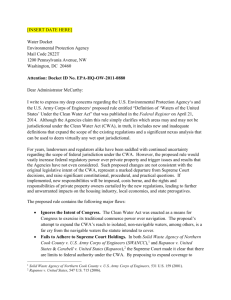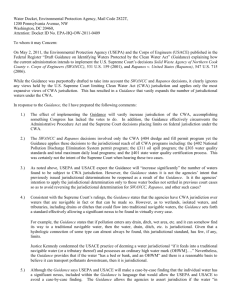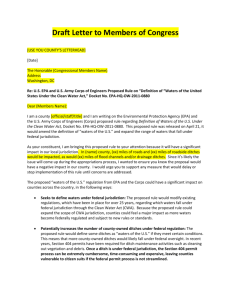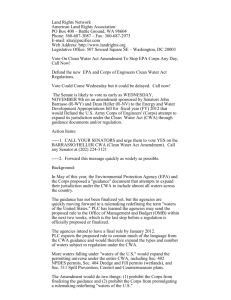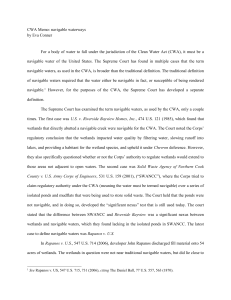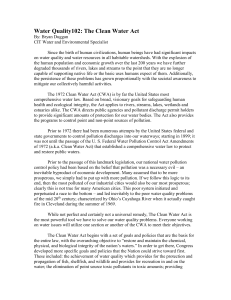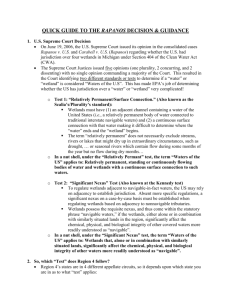Outline of PowerPoint Presentaton
advertisement
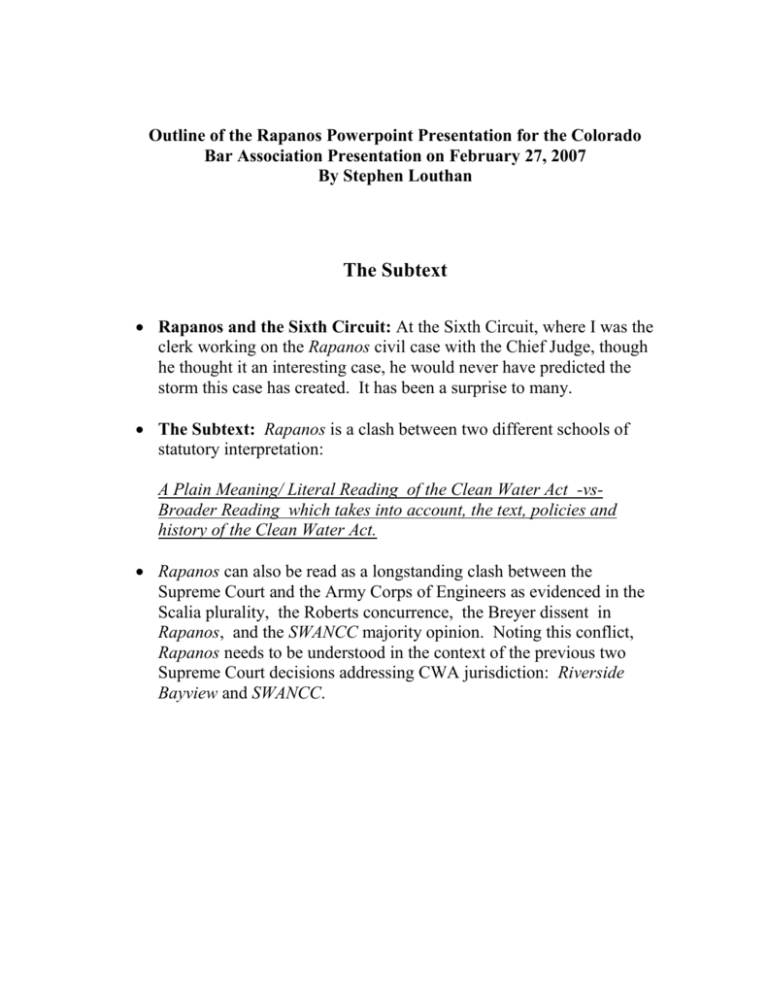
Outline of the Rapanos Powerpoint Presentation for the Colorado Bar Association Presentation on February 27, 2007 By Stephen Louthan The Subtext Rapanos and the Sixth Circuit: At the Sixth Circuit, where I was the clerk working on the Rapanos civil case with the Chief Judge, though he thought it an interesting case, he would never have predicted the storm this case has created. It has been a surprise to many. The Subtext: Rapanos is a clash between two different schools of statutory interpretation: A Plain Meaning/ Literal Reading of the Clean Water Act -vsBroader Reading which takes into account, the text, policies and history of the Clean Water Act. Rapanos can also be read as a longstanding clash between the Supreme Court and the Army Corps of Engineers as evidenced in the Scalia plurality, the Roberts concurrence, the Breyer dissent in Rapanos, and the SWANCC majority opinion. Noting this conflict, Rapanos needs to be understood in the context of the previous two Supreme Court decisions addressing CWA jurisdiction: Riverside Bayview and SWANCC. The Problem and its Size Amount of Land at Issues: If we take Scalia’s interpretation, the amount of the land at issue affected by the Rapanos decision is the size of California and half the size of Alaska combined. Furthermore, out west, the issue in Rapanos could have significant affect on intermittent streams and arroyos. However, this will not become clear until the EPA and the Corps issue guidance. The Crux of the Problem: These cases all highlight the ambiguity in the Clean Water Act’s definition of “navigable waters.” All CWA programs, including 404, regulate “navigable waters” which is defined as “the Waters of the United States” which Congress decided not to elaborate upon. Rapanos involved the 404 program. Regulators Step In: Lack of Congressional action to define “the Waters of the United States” has left this job to the regulators, which in turn has resulted in a long score of lawsuits concerning the Corps’ jurisdiction under the CWA and a heightened animosity towards regulation. 2 Riverside Bayview First Supreme Court Case on CWA Jurisdiction: Riverside Bayview (1985) was the first case the Supreme Court heard concerning the scope of the CWA jurisdiction. The question posed is whether a wetland adjacent to a navigable waterway fell under the scope of the CWA jurisdiction. Three critical points to take away from Riverside Bayview: Adjacency the Issue: Coloradan’s Justice White’s unanimous opinion based its finding of jurisdiction on adjacency to the waterway, and not whether there was a hydrological connection. Broad Reading of the Statute: Second, the unanimous court grounded its decision by reasoning the Corps’ assertion of jurisdiction was in line with language, policies and history of the CWA. Finally, though perhaps not agreeing with the reasoning, every opinion in Rapanos agreed with the Riverside Bayview precedent. A Macro View of the Wetlands Ecological Role: Third, the court’s discussion emphasized the Wetlands integrated role in the broader eco-system. Unlike SWANCC and Rapanos, the influence of Science and Ecology is far more apparent in Riverside Bayview. 3 SWANCC and The Migratory Bird Rule The Migratory Bird Rule: This rule was developed and implemented around the time Riverside Bayview came down, some have interpreted basing jurisdiction over isolated intrastate ponds on their use by migratory birds as an emboldened move because of the 90 decision in Riverside Bayview. A Question of Jurisdiction: Assertion of jurisdiction vis-a-vis the Migratory Bird Rule led directly to the conflict in SWANCC even though it took 16 years to reach the court. The SWANCC specifically noted how APA was not followed in issuing the rule. SWANCC Looks to Congressional Intent: The SWANCC court majority looked to congressional intent of the CWA and found none concerning whether Congress wanted jurisdiction to extend to isolated ponds used by migratory birds that crossed state lines and ultimately decided the Corps did not have jurisdiction in this situation. 4 The Agencies’ Response to SWANCC Quick: Ten days after SWANCC, the EPA and the Corps issued a joint legal memorandum explaining that SWANCC focused on a narrow type of waters: isolated, non-navigable, and intrastate. Cumbersome: In early 2003, the EPA and the Corps issued joint guidance clarifying SWANCC which stated the agency should not assert CWA jurisdiction based solely on the presence of migratory birds. Along with the Guidance in issued in 2003, the EPA and Corps released an Advanced Notice of Proposed Rule making in light of SWANCC. The wheels of regulatory process started and 44 states, 4 tribes, 130,000 commented; however, I final rule was never released. The Supreme Court’s attack on Agency Inaction: The Scalia plurality, the Roberts concurrence, and Breyer dissent imply the lack of action by the Corps after SWANCC created this problem, which courts unfortunately must decide on an ad hoc basis. Is this a fair assessment in light of what the agencies did do? 5 The Lower Courts’ Response to SWANCC Significant Nexus Ambiguity: The majority in SWANCC fashioned what might be called a new test, the significant nexus test; unfortunately its language is as general and undefined as the CWA’s “waters of the United States” and the lower courts applied to a wide variety of different fact patterns. The Test: Under this test, the court looks to see if there is a significant nexus between the body of water in question and the interstate navigable waterway. Courts’ Reaction: Since SWANCC the lower courts have all applied the magic language of “significant nexus,” and all the circuits, except for the 5th Circuit, have narrowly interpreted SWANCC. Since SWANCC we have 19 appellate circuit decision, 17 of which view SWANCC as not significantly affecting CWA jurisdiction. 6 The Confusion of Rapanos Long on Attack, Short on Substance: Perhaps a bold statement, but it is the antithesis of what a Supreme Court decision should be. Five opinions in all, three of substance, Rapanos is approximately twice the size of SWANCC and Riverside Bayview put together. What’s the Rule: Because of the 4-1-4 split plurality decision, the Scalia plurality, the Kennedy concurrence, and the Stevens dissent, it has resurrected old problems as to which opinion controls. Under the rule laid out in Marks, the opinion that concurs in judgment on the narrowest grounds is in theory the controlling opinion. Did Justices Stevens and Roberts throw out Marks? Noting Justice Stevens’ dissent, which endorses jurisdiction if either test is met, and Justice Roberts’ concurrence which notes that lower courts are left to deal with CWA jurisdiction issues on a case-by-case basis, there is a certain amount of confusion on what the rule of Rapanos is and subsequent case law bears this out. The Department of Justice is now using both tests when prosecuting CWA cases. As an important legal theory matter, has the rule of Marks become dead letter? 7 The Scalia Rule Statute Based: As often noted, on Scalia’s theory of statutory interpretation, which apparently the new Justices Alito and Roberts adopt, legislative history is irrelevant; rather the text and the canons of statutory construction are utilized to arrive at the correct interpretation of the statute. Scalia’s Reasoning: Noting Scalia’s theory of statutory interpretation, Scalia did not ever explicitly cite any canons of statutory construction, but instead relied on Webster’s Dictionary definition of “waters” focusing on the difference between the phrase “water of the United States” and “the waters of the United States.” If the former, the Kennedy concurrence and the plurality might be correct. However, the use of the term “the” and plural nature of waters indicates that it falls within Webster’s Dictionary definition which states “as found in streams and bodies forming geographical features such as oceans, rivers and lakes … or the flowing or moving masses as of waves or floods making up such streams or bodies.” Webster’s New International Dictionary, 2882 (2d ed. 1954). The Scalia Plurality Test: The Scalia plurality arguably formulated three very similar rules concerning CWA jurisdiction. I find the rule articulated at Headnotes 11 and 12 to be the best summation. For the water at issue to fall under the Corps’ jurisdiction, the water must be connected to a permanent body of water connected to a traditional interstate navigable waters, and the water at issue must have a continuous surface connection with navigable waters. Does the Scalia rule have a major impact out west, the perplexing nature of footnote 5: In footnote five, the Scalia plurality still notes, despite their emphasis on a continuous water connection, that seasonal rivers which contain some flows during may still fall within CWA jurisdiction. There is a difference between a wash and seasonal river. 8 The Kennedy Rule Judicially Crafted: Unlike the Scalia plurality who focused on defining the statutory term “waters of the United States,” Kennedy focused much more specifically on wetlands and the judicially crafted rule in SWANCC, the significant nexus test. The Kennedy Test: If the wetland is adjacent to the navigable waterway, the adjacency itself establishes jurisdiction. However, if the wetland is adjacent to a non-navigable waterway, a significant nexus must be established on a case-by-case basis. Prior to this statement, Justice Kennedy does state the “requisite nexus is met if the wetlands either alone or in combination with similarly situated lands in the region, significantly affect the chemical, physical and biological integrity of waters understood as navigable.” The Kennedy Wild Card: In his discussion of Carabell, Justice Kennedy noted that the absence of a hydrological connection may even create a significant nexus. In other words, Justice Kennedy implies that there can be actions to wetlands or, with a broader interpretation, perhaps even non-wetlands where there is no hydrological connection, but if the action significantly affects the biological integrity of navigable waters, could there be jurisdiction? Did Justice Kennedy open Pandora’s Box and perhaps even widen the scope of jurisdiction? 9 Downstream Flow and Hydrology Kennedy and Hydrological Connections: Putting aside the conundrum noted above, when you work through Justice Kennedy’s analysis of the specific problems in Carabell and Rapanos, at the very least Justice Kennedy’s rule has redefined the role of a hydrological connection. Downstream Water Quality: A hydrological connection is apparently not dispositive, rather what is at issue is the action’s affect on “downstream physical chemical biological integrity.” Depending on what is going on upstream, the connection is almost irrelevant if the downstream water quality is being significantly affected. My Ecological Consultants: ……what scientists in the field might be doing in the future ….. to be added 10 Summary Scalia Plurality: The plurality attempted to ascertain the plain meaning of the text using the Webster’s Dictionary as a fulcrum for their interpretation of “waters of the United States.” Though Scalia may have implicitly attempted to use canons of statutory construction to interpret the law, he did not mention any. Finally, true to Scalia form, the plurality avoided the legislative history. The Kennedy Test: A judicially crafted rule which potentially replaces essentially 30 years of regulatory standards by emphasizing the language “significant nexus” which now focuses on downstream water quality. Potentially, a much different application of the term than its original crafting in SWANCC. Stevens’ Dissent : The dissent applied Chevron deference to the agencies rule making finding nothing arbitrary and capricious in light of the language, policies and history of the CWA. Essentially the same reasoning as Justice White in his 9-0 Riverside Bayview opinion. 11
